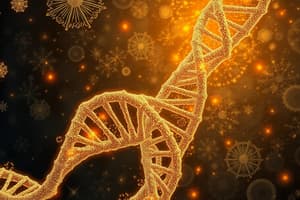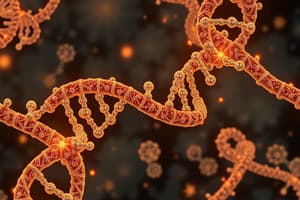Podcast
Questions and Answers
What specifies a male's biological sex in terms of sex chromosomes?
What specifies a male's biological sex in terms of sex chromosomes?
- XX
- XY (correct)
- YY
- X0
Why are the X and Y chromosomes considered exceptions to the rules of homologous chromosomes?
Why are the X and Y chromosomes considered exceptions to the rules of homologous chromosomes?
- They have only one chromosome each.
- They do not contain any genes.
- They are the same size and shape.
- They do not have the same genes in the same places. (correct)
What connects sister chromatids before cell division?
What connects sister chromatids before cell division?
- Chromatin
- Telomeres
- Centromere (correct)
- Kinetochore
What is the total number of autosome pairs in human cells?
What is the total number of autosome pairs in human cells?
Which structure contains repeated DNA sequences and is rich in adenine-thymine?
Which structure contains repeated DNA sequences and is rich in adenine-thymine?
What enzyme is responsible for synthesizing and maintaining the length of telomeres?
What enzyme is responsible for synthesizing and maintaining the length of telomeres?
What are the ends of each chromosome, consisting of short TG-rich repeats, called?
What are the ends of each chromosome, consisting of short TG-rich repeats, called?
What pair of chromosomes are classified as heterosomes?
What pair of chromosomes are classified as heterosomes?
What defines tandemly repeated DNA?
What defines tandemly repeated DNA?
Which of the following statements about long interspersed elements (LINEs) is correct?
Which of the following statements about long interspersed elements (LINEs) is correct?
How is mitochondrial DNA (mtDNA) primarily inherited?
How is mitochondrial DNA (mtDNA) primarily inherited?
What role do the proteins coded by mtDNA play?
What role do the proteins coded by mtDNA play?
Which of the following best describes the structure of human satellite DNA?
Which of the following best describes the structure of human satellite DNA?
What is the primary function of telomerase in cells?
What is the primary function of telomerase in cells?
Which term describes the chromatin that is densely packed and generally inactive?
Which term describes the chromatin that is densely packed and generally inactive?
How does DNA methylation typically affect gene transcription?
How does DNA methylation typically affect gene transcription?
What is the primary difference between constitutive and facultative heterochromatin?
What is the primary difference between constitutive and facultative heterochromatin?
What role does histone acetylation play in gene regulation?
What role does histone acetylation play in gene regulation?
What characterizes repetitive-sequence DNA in the human genome?
What characterizes repetitive-sequence DNA in the human genome?
Which statement regarding introns in eukaryotic genes is accurate?
Which statement regarding introns in eukaryotic genes is accurate?
What is true about the staining properties of euchromatin compared to heterochromatin?
What is true about the staining properties of euchromatin compared to heterochromatin?
Which statement correctly describes histones?
Which statement correctly describes histones?
What is the primary purpose of nucleosomes in DNA organization?
What is the primary purpose of nucleosomes in DNA organization?
Which component is not part of the chromatin structure?
Which component is not part of the chromatin structure?
How many base pairs are approximately wrapped around a histone octamer?
How many base pairs are approximately wrapped around a histone octamer?
Which of the following is true about homologous chromosomes?
Which of the following is true about homologous chromosomes?
What happens when a sperm and an egg fuse?
What happens when a sperm and an egg fuse?
What defines the position of a gene within a chromosome?
What defines the position of a gene within a chromosome?
Which statement about the H1 histone is correct?
Which statement about the H1 histone is correct?
Flashcards
Sex Chromosomes
Sex Chromosomes
Chromosomes (X and Y) that determine biological sex.
Autosomes
Autosomes
The 44 non-sex chromosomes in humans.
Sister Chromatids
Sister Chromatids
Two identical copies of a chromosome.
Karyotype
Karyotype
Signup and view all the flashcards
Homologous Chromosomes
Homologous Chromosomes
Signup and view all the flashcards
Centromere
Centromere
Signup and view all the flashcards
Telomeres
Telomeres
Signup and view all the flashcards
Chromatids
Chromatids
Signup and view all the flashcards
Histones
Histones
Signup and view all the flashcards
Nucleosomes
Nucleosomes
Signup and view all the flashcards
Chromosomes
Chromosomes
Signup and view all the flashcards
Diploid (2n)
Diploid (2n)
Signup and view all the flashcards
Haploid (1n)
Haploid (1n)
Signup and view all the flashcards
Dispersed Repeated DNA
Dispersed Repeated DNA
Signup and view all the flashcards
Tandemly Repeated DNA
Tandemly Repeated DNA
Signup and view all the flashcards
LINEs
LINEs
Signup and view all the flashcards
SINEs
SINEs
Signup and view all the flashcards
Satellite DNA
Satellite DNA
Signup and view all the flashcards
Telomerase Function
Telomerase Function
Signup and view all the flashcards
Telomerase and Aging
Telomerase and Aging
Signup and view all the flashcards
Telomerase and Cancer
Telomerase and Cancer
Signup and view all the flashcards
Heterochromatin
Heterochromatin
Signup and view all the flashcards
Euchromatin
Euchromatin
Signup and view all the flashcards
Constitutive Heterochromatin
Constitutive Heterochromatin
Signup and view all the flashcards
Facultative Heterochromatin
Facultative Heterochromatin
Signup and view all the flashcards
DNA Methylation
DNA Methylation
Signup and view all the flashcards
Study Notes
DNA Organization
- Mitosis begins in five minutes; DNA needs to condense.
- DNA organization is crucial for cell division
- Learning objectives include DNA organization (histones, chromatin, chromosomes, karyotyping), the cell cycle (phases, regulating proteins/enzymes), and cell cycle regulation (checkpoints).
DNA Organization Details
- Nucleosomes: Composed of nucleoproteins (DNA and basic proteins)
- Chromatin: DNA, being a meter long in a human cell, must condense into a compact structure. Chromatin is condensed DNA, composed of:
- long, double-stranded DNA
- Histones (basic proteins, positively charged, rich in lysine & arginine)
- Other basic proteins
- Small amounts of RNA
- Histones and Nucleosomes: Histones form complexes called nucleosomes. Each nucleosome contains DNA wound around eight histone proteins. These histones are H1, H2A, H2B, H3, and H4. Two of each histone (H2A, H2B, H3, and H4) come together to form a histone octamer that binds about 146 base pairs. Addition of an H1 protein wraps another 20 base pairs.
- H1 Histone: The least tightly bound histone (linker histone). Easily removed with salt solution. Removing H1 makes the chromatin soluble.
Chromatin Packaging
- DNA is packaged into a series of increasingly condensed structures to fit into the cell nucleus.
- Starting from the DNA double helix, packaging includes:
- Beads-on-a-string
- 30-nm chromatin fiber (packed nucleosomes)
- Condensed sections
- Entire mitotic chromosome
- DNA is typically 50,000 times shorter in a condensed state than its extended length.
Genome and Genes
- Genome: The total chromosomal DNA content in a somatic cell (23 pairs of chromosomes)
- Gene: A part of a chromosome located at a specific position (locus).
Homologous Chromosomes
- Chromosomes come in matched sets, known as homologous pairs (diploid-2n).
- Humans have 46 chromosomes organized into 23 pairs, and the two members of each pair are homologues (except for the X and Y chromosomes)
- Human sperm and eggs have only one chromosome from each pair (haploid-1n)
- Genetic material from haploid sperm and egg combines to form a complete diploid set.
- Homologous chromosomes are very similar, having the same size, shape, and genes in the same locations.
- Sex chromosomes (X and Y) determine sex (XX=female, XY=male). They are not true homologues, as the genes are not identical in the same locations in all instances.
- Autosomes: The 44 non-sex chromosomes in humans.
Chromatids
- A single DNA molecule replicates to make two identical strands called chromatids.
- Chromatids remain connected at the centromere.
- During cell division, once chromatids separate, each becomes a separate chromosome.
Karyotypes
- Chromosomes from a dividing cell can be photographed and organized into matching pairs.
- Each pair has a specific size, shape, and banding pattern.
- Karyotypes are used in genetic analyses, identifying variations from normal chromosome structure or numbers.
Telomeres
- Telomeres are structures at the ends of each chromosome, composed of short TG-rich repeats.
- Telomeres protect the ends of the chromosome from degradation or fusion with other chromosomes.
- Human telomeres have variable numbers of 5'-TTAGGG-3' repeats.
- Telomerase is an enzyme that maintains telomere length. Telomerase employs reverse transcriptase to extend telomeres.
- Telomere shortening is linked to aging and malignant transformation.
Heterochromatin and Euchromatin
- Heterochromatin: Transcriptionally inactive, densely packed chromatin.
- Euchromatin: Transcriptionally active chromatin; stains less densely than heterochromatin and is less tightly bound.
Chromatin Types
- Heterochromatin (tightly packed): found in regions of chromosomes where there are few or no genes. Two types: constitutive and facultative. Function as regulator of gene expression.
- Euchromatin (loosely packed): found in regions of chromosomes where there are many genes. Unfolded structure; function in active transcription of DNA to mRNA.
- Constitutive heterochromatin: Always condensed, inactive chromatin. Located near centromeres and at chromosome ends (telomeres)
- Facultative heterochromatin: Can be condensed or uncondensed (and thus transcribed) and appear as euchromatin. This dynamic state implies various functional states for a given gene. A well-known example is the X chromosome in females, one of which is heterochromatic to regulate gene expression.
DNA Methylation
- DNA methylation is the attachment of methyl groups (-CH3) to DNA bases after DNA synthesis. Inactive DNA is usually highly methylated compared to actively transcribed DNA.
- Demethylating inactive genes promotes their activation.
Histone Acetylation
- Histone acetylation (adding acetyl groups) plays a role in gene transcription.
- Acetylation of histones lessens their grip on DNA which makes DNA less tightly wound and easier for transcription proteins to work in this region and thus improves transcription rates.
Noncoding Intervening Sequences (Introns)
- mRNA molecules often have noncoding regions within coding regions known as introns.
- Introns are sequences that interrupt the coding regions (exons) of a gene.
- In most cases, introns are significantly longer than exons.
Sequence Classes of DNA
- Unique-sequence DNA: Non-repetitive DNA, single-copy genes that code for proteins.
- Repetitive-sequence DNA: Sequences that appear multiple times in the genome (variable copy number from 2 to 107 copies per cell).
- Repetitive DNA can be:
- Dispersed (irregular intervals)
- Tandem (repeated many times in a row)
Interspersed Genome-Wide Repeats
- Families of repeated sequences, dispersed throughout the genome.
- These sequences are either short or long; some are mobile elements.
- Transposons: Mobile DNA sequences that migrate to different regions via transposition.
- Retrotransposons (retroviral-like elements): mobile elements. Another type of mobile element and they are very common in genomes.
Satellite DNA
- Satellite DNA: Large arrays of tandemly repeated DNA with repeat units being a simple/moderately complex sequences (100kb to several Mb). These repeats are not normally transcribed.
- Types of satellite repeats: Microsatellite, Minisatellite.
Mitochondrial DNA (mtDNA)
- mtDNA is a small circle of 16 kbp dsDNA that is present in multiple copies per cell.
- About 54 polypeptides involved in mitochondrial functions are coded from nuclear genes, and the remainder by mtDNA.
- mtDNA codes for mitochondrial rRNA, tRNA and 13 proteins involved in respiration, and other cellular processes.
- Mitochondria are maternally inherited. In cases of diseases caused by mtDNA mutations, all children can inherit the disease, but only the daughters can transmit the trait.
Studying That Suits You
Use AI to generate personalized quizzes and flashcards to suit your learning preferences.




